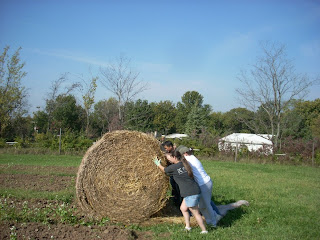So Much to Give Thanks For
As we harvest and pack the shares we are thankful for the bounty remaining in the fields. Folks are becoming more aware of the multiple benefits of local food, and we are happy to have fresh produce available in late November, when such things can be sparse. With a little help from modern technology (ie, floating row cover made of spun polyester—an agricultural leisure suit), we have been able to protect many of the more tender plants from the low 20° F nights.
Thanksgiving is often a brown (turkey, stuffing and gravy), white (potato) and orange (sweet potatoes and winter squash) affair. The many greens in the share are a great addition to this standard fare. Not only do they add color, but also those many “green” nutrients missing once summer is gone. We feel they also help make a large meal more digestible, especially when eaten raw. We hope to make these shares an annual affair, and hope a few of these recipes become traditions with your family.
 Fennel & Escarole Stuffing with Pine Nuts We tried this dish last Friday, with a few modifications. We didn’t have pine nuts so we used roasted shelled pumpkin seeds. And not having any white wine around, we used half white wine vinegar and water. The result was delicious, with a little bitterness from the escarole. We haven’t tried it again, but next time will use a little less escarole and maybe add some raisins or other dried fruit.
Fennel & Escarole Stuffing with Pine Nuts We tried this dish last Friday, with a few modifications. We didn’t have pine nuts so we used roasted shelled pumpkin seeds. And not having any white wine around, we used half white wine vinegar and water. The result was delicious, with a little bitterness from the escarole. We haven’t tried it again, but next time will use a little less escarole and maybe add some raisins or other dried fruit.
Lettuce Spinach Salad with Carrot, Fennel and Grated Root Vegetable A great way to sample five share items at once. Simply wash and tear up the lettuce and de-stemmed spinach into a salad bowl. Cut the tops and root end off a fennel bulb, cut it in half (from top to bottom), and then cut into thin slices. Add to the salad along with grated carrot and turnip or beet. Toss before serving and garnish individual salads with sunflower or pumpkin seeds.
Creamy Lemon Herb Dressing A perfect topping for the salad, the dill and cilantro give this dressing a fresh, Spring-like taste.
Brussel Sprouts with Butter and Cheese Brussel sprouts are something to keep simple when cooking. Snap the individual sprouts off the stalk and clean off any raggedy leaves. Cut larger sprouts in half. Put in a saucepan with about ½ inch of water in the bottom. Cover and cook for 5 minutes, or until sprouts are tender. Drain, put back in pan and add 1 tbsp or more of butter. Serve warm and top with grated cheese (parmesan or cheddar) or crumbled fresh cheese (goat cheese or feta).
Swiss Chard with Vinegar and Egg The recipe in the newsletter calls for kale, but Swiss chard is just as good. And of course local pasture raised chicken eggs from Parker Farms are an excellent addition.
Cole Slaw This is a standard recipe filled with locally available ingredients. Cole slaw recipes are abundant, check your relatives or the web for a perfect one. Don’t be shy to grate turnips or fennel into yours. Dill can be a nice addition too.
NEED TO KNOW MORE? Go to our Recipe page and search.













